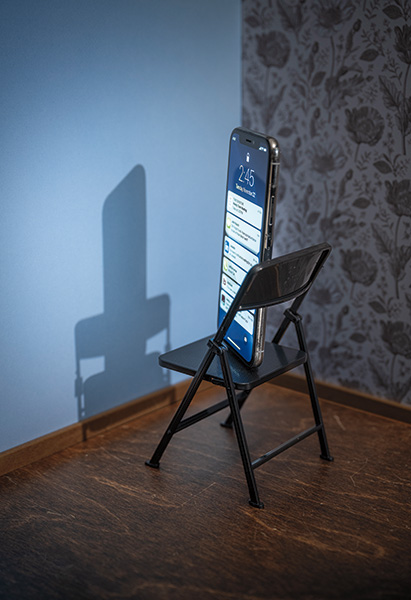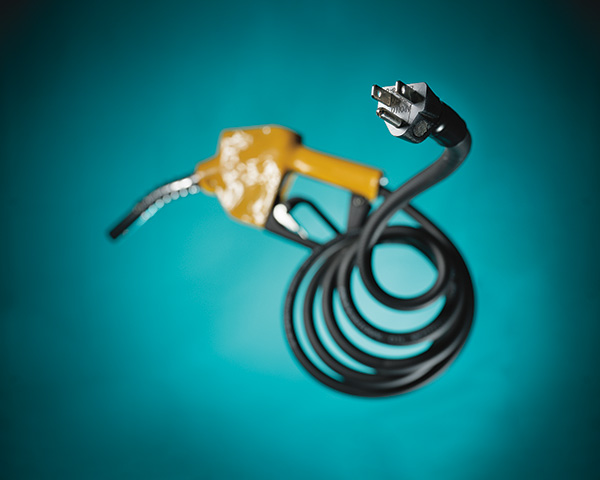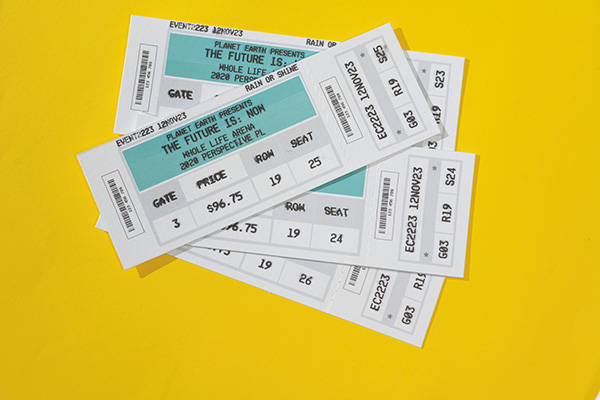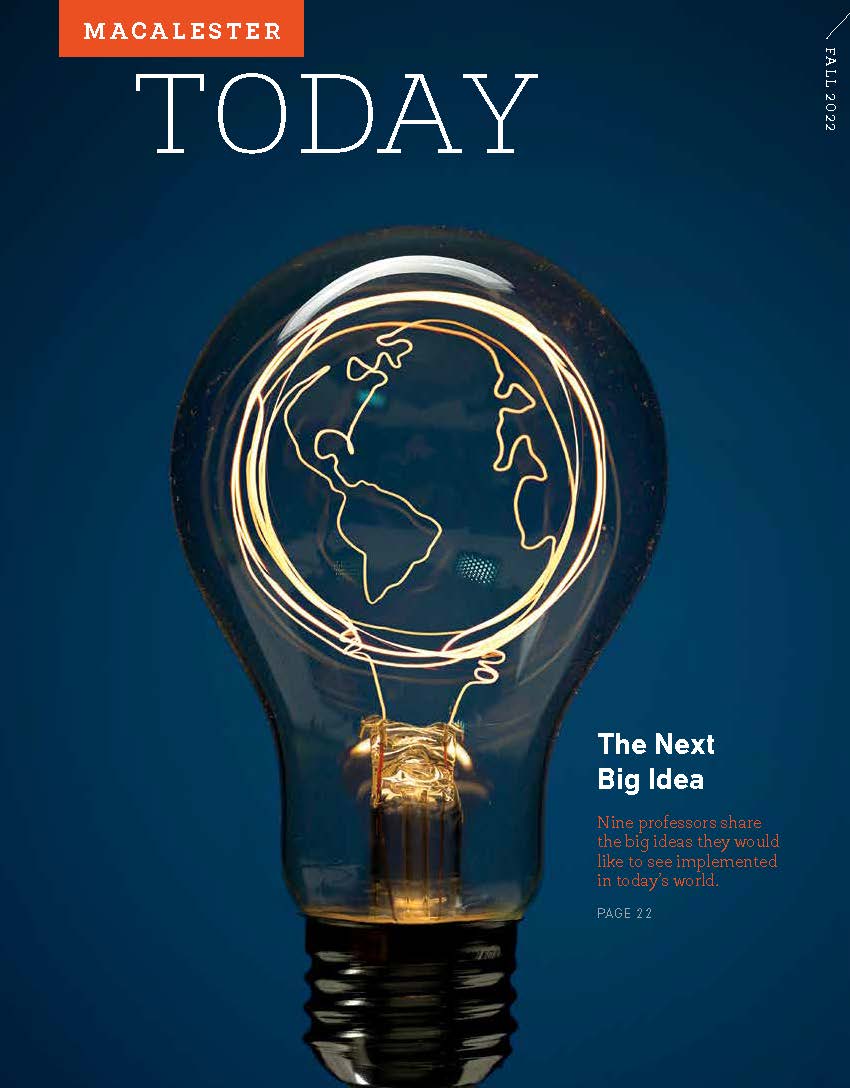
By Erin Peterson / Photo Illustrations by Charles Jischke
In a pandemic-shadowed world, it’s easy to think small: To imagine a world in which we tamp down our biggest dreams and place limits on what seems possible.
But Macalester is designed to help people see opportunities all around them. Earlier this year, we reached out to professors with a question meant to reveal those possibilities: If they had all the necessary time, resources, and political will, what is an idea they’d like to see fully implemented in the world today?
And across the board, they thought big—really big.
They painted pictures of transformed schools that inspired truly meaningful student learning. They shared the paths they saw to a world filled with people who were generous rather than judgmental. They illuminated their visions of a world of abundance, not scarcity. They also suggested you tuck away those screens for—gulp—a two-week digital vacation.
We’re excited to showcase their ideas.
Big Idea No. 1: Keep the Arctic cold
Mary Heskel is an assistant professor of biology.
A lot of people think of the Arctic as a barren, lifeless region. Certainly, many people don’t think about it much when creating policies at lower latitudes. But what happens in the Arctic doesn’t stay in the Arctic. Things are changing fast there, and the consequences will be seen everywhere.
For example, recent calculations show that it’s warming more than four times faster than the rest of the planet—which is a problem, because the Arctic is a huge carbon reservoir and regulates climate and weather patterns in lower regions. The white, energy-reflecting ice cover has been shrinking, and the dark, heat-absorbing ocean is expanding. Fish that used to live around Maine now can live near Greenland, altering the marine ecosystems. Spruce and birch trees live much farther north than they have in millennia.
Scientists and engineers are coming up with all sorts of unconventional ideas to try to solve this problem. One idea is to release aerosols into the high atmosphere to dim the sun. Another research group wants to use DNA splicing technology to bring back woolly mammoths to help reshape the Arctic ecosystem. In theory, mammoths would trample the over-shrubbed and heat-absorbing forests and help revert the area to arctic grasslands, which do a better job at reflecting the sun’s heat and keeping the ground cold. There are also companies developing technology to suck carbon dioxide out of the atmosphere. The better—if politically unpopular—option is to stop burning fossil fuels, which promote warming. To me, it says a lot about the urgency of the problem that scientists are coming up with these extreme and out-of-the-box ideas, because if we can’t save the Arctic through politics, what else can we do?
We’re at a tipping point, so we’ve got to keep it cool.
Big Idea No. 2: Get the lead out (for good)
Gabriel Lade is an assistant professor of economics.
We’ve known for literally thousands of years that lead exposure can lead to health and behavioral problems. It’s why we started phasing out the use of lead in products like fuel and paint in the 1970s and 1980s in the United States. We know now that any exposure is bad, especially for sensitive populations such as children and older adults. How big is the problem? One study suggests that eliminating small amounts of lead from fuel had the same health benefits as reducing other air pollutants by 90 percent.
The problem is that there is a lot of “legacy lead” out there in materials that predate the bans that have been implemented over the decades. There are also a few loopholes to lead bans. Examples include lead service lines that deliver water to many homes in the United States, lead-based paint, and fuel used in classic cars, motorcycles, and some small airplanes.
We should get rid of it all. That’s not just eliminating it from any current uses. We should also subsidize households to replace service lines and windows that have lead paint, common in those built in the mid-1970s or earlier.
Yes, it will be expensive. Replacing service lines—mostly found in homes built before the mid-1980s—can cost thousands of dollars per household, and some studies suggest at least ten million people live in the households that may be affected. While President Biden recently announced a plan to replace these lead water lines within the decade, funding may not be sufficient to do so.
That said, we know that when we reduce lead exposure, we see decreases in older adult and child mortality. We also know that reducing lead exposure can reduce cognitive and behavioral problems that affect all aspects of individuals’ lives. Further, in areas where service lines have been replaced, research finds that home values increase up to and even beyond the cost of the replacement.
Lead exposure can lead to tremendous and lasting losses, even above the many health problems it causes. My own research on the housing market impacts of the Flint water crisis provide a prime example of the detrimental effects and risks of legacy lead in our lives. It’s time to mandate its removal.
Big Idea No. 3: Take students into communities through experiential learning
Brian Lozenski is an associate professor of educational studies and chair of the department.
When the pandemic hit and schools moved to Zoom—when the social cohesion of school was fundamentally disrupted—school became very different. At first, the task before educators felt straightforward: Can students learn this packet of information?
That moment led to larger, important questions: What is the purpose of school? Is it just preparation for the future? What if school could actually be for right now?
We need a fundamental reconceptualization of education. We need to incorporate far more hands-on, experiential learning in our school curricula and take students into their communities. Much of it should be in the service of democratic engagement, not simply learning skills for some time in the future.
We don’t need to start with a blank canvas. In a place like St. Paul, students could be engaged in political activities happening at the State Capitol or in business boardrooms. I’ve seen examples of schools being run as student co-ops. There are schools that exist on an operating farm, and part of school is about participating in life on that farm.
When students are helping construct their own educational environments and outcomes, when young people are participating in the conversation about important issues, it can be such a rich experience. They gain a desire to be truly engaged in their communities. Schools would also become a central site of problem solving for whatever a community is facing—economic challenges, social cohesion issues, or housing issues.
For example, in St. Paul Public Schools, the Student Engagement and Advisory Board, an extracurricular organization, encouraged the school board to develop a curriculum for the district in ethnic studies; after some significant back and forth, the board ultimately mandated it as a graduation requirement. But this kind of work doesn’t need to be extracurricular—it can be part of every student’s experience.
If we don’t change now, when will we ever be willing to make these changes? Writer Arundhati Roy says the pandemic is a portal—a gateway between one world and the next. What are we holding on to? It’s time to rethink what education can be.

Big Idea No. 4: Incorporate data analysis and machine learning into farming and agriculture
Lori Ziegelmeier is an associate professor of mathematics, statistics, and computer science.
I grew up on a farm in rural Kansas, where my dad primarily farmed field corn, wheat, and soybeans, and raised cattle.
Technology has advanced a lot in the farming industry over the years. When I was growing up, my dad would use flood irrigation techniques—laying pipes to flow water down small trenches through crops—but it’s inefficient and can lead to runoff. Today, it’s more common and efficient to use pivot irrigation sprinklers, machines that rotate around a central pivot, to water crops. But there is so much more that we could do to deploy our resources more effectively.
For example, rather than water the whole field equally with pivot irrigation sprinklers, we could use a combination of drone imaging and spectral signatures to determine how much water certain parts of a field actually need, which could reduce water usage.
We could do the same with disease or pest control: rather than spraying an entire field with pesticides, we could do more targeted treatments.
We could even create robots that use machine learning to distinguish between weeds and crops. Those robots could remove the weeds so we wouldn’t have to use herbicides at all.
Some of these strategies are already being implemented on a small scale, but they’re not yet mainstream. As the world population continues to grow, as drought conditions accelerate, and as farming conditions continue to deteriorate, using data analysis and machine learning could have a huge impact and help farmers continue to feed the world.
Big Idea No. 5: Make a gap year after high school mandatory
Hannah Kim is an assistant professor of philosophy.
My proposal is to make students take a year off after high school before they go to college or do anything else. For six months, they’d hold down a service-industry job or a white-collar internship in a region or state they’re not from, depending on the kinds of experiences they’ve already had in high school. For another six months, they’d spend time abroad.
Here’s why: In my classes, my students and I talk about “epistemic communities.” These are communities—friendships, political groups—in which the people share a common set of beliefs or ways of looking at the world. We are all in epistemic communities.
The problem is, if you’re trying to communicate with someone from a different epistemic community, the things that will be compelling to you will not be as compelling to them. There’s not a common platform for understanding. One way to expand our understanding of others is just to meet many different kinds of people in many different situations.
In my proposal, high school graduates would be primed to take on the perspectives of very different kinds of people and different kinds of lives that they couldn’t have imagined as students. Hopefully, they would form lifelong friends that would open them to thinking beyond what they learned from their parents or at school.
The point is not that students specifically spend time in service-industry jobs, white-collar internships, or even in international locations. The larger goal is to encourage meaningful relationship building across different kinds of people who might not naturally intersect.
In the end, I want to help people become more empathetic, open-minded individuals who can think for themselves, in part because of the rich experiences they’ve had.
Big Idea No. 6: Take a two-week digital sabbatical
Victoria Malawey is a professor of music.
My idea is for everyone to take a two-week digital sabbatical from the internet and their phones.
I found it illuminating that when Apple started showing us our screen time each week, at first we were mortified. Then we just turned that notification off, because we didn’t want to know.
My hope is that this break would rewire our brains to be more present in our physical environments and to approach others with curiosity. If we spent more time face to face with people, I think many of us would be better versions of ourselves.
This isn’t just about the problems of social media. I know that for myself, sometimes I’ll get an email when I’m in the wrong mood for it, and I’ll whip up a response that isn’t as thoughtful as it would have been if I’d been speaking to the sender in person.
As social creatures, we need to connect with others for our survival. But if we’ve learned anything from the pandemic, it’s that digital connection is helpful but does not fulfill our need for physical human connection.
When we turn the screens off, we will be forced to seek connection in analog ways. This type of connection—where we speak with one another, see and respond to each other’s body language, and simply be present with one another in the same physical space—is optimal. A digital sabbatical could help us cultivate better, truer connections with one another.

Big Idea No. 7: Shift everything to electric, then move to renewable energy
Chris Wells is a professor of environmental studies and chair of the department.
The single biggest challenge right now is climate change, and the most significant contributor to climate change is the combustion of fossil fuels.
United Nations data suggests that the world can emit just 300 additional gigatons of carbon into the atmosphere before we push the planet past 1.5 degrees Celsius of warming—after which we are highly likely to see some of the most devastating consequences of climate change. To put that in context, in 2019, we emitted 33 gigatons of carbon. So there’s a really pressing need to shift away from fossil fuel technologies to electric technologies supplied by renewables much faster than we are.
This means putting electric motors in vehicles and replacing the oil and natural gas boilers in people’s basements with electrical technologies like heat pumps. To do so, we really need to be thinking at the systems level, and in even bigger ways than the recent Inflation Reduction Act that includes billions to support the transition to clean energy.
Instead, we need “moonshot strategies,” both in the U.S. and internationally, to overcome seemingly impossible barriers in a short time. There are many policy levers to pull and incentives to offer to shape markets, including subsidizing renewable energy production, supporting the technological advancement in areas such as solar panels and wind turbines, and offering incentives in the form of rebates to lower the upfront costs of electric cars.
There’s no “one thing” that a single country can do, but globally, nations need to start pulling as many of these policy levers as they can, as quickly as they can, to solve this global problem.

Big Idea No. 8: Accelerate meaningful learning through virtual reality environments
Walter Greason is the DeWitt Wallace Professor of History and chair of the department.
For too long, we’ve been bogged down in nineteenth-century ideas about how teaching and learning work.
In most classrooms, we have to train people intensely for long periods of time in ways that are not natural or automatic. Here’s what I mean: we don’t learn to walk by reading about walking—we learn to walk by practicing and failing. Experiential learning is profound.
In contrast, immersive virtual reality environments found through technology like Meta’s Oculus—where you can see, hear, and synthesize data in ways similar to what we’ve been doing since we were born—open new frontiers for retention and innovation. I believe they can become a regular part of the way we do education.
For example, I recently finished work on a scholastic simulation about the Civil Rights movement that enables students to walk through a historic Black community, meeting with local church and business leaders, as they discuss different opinions about how to challenge racial segregation effectively. This is the kind of experience that can open students up to new ideas and new questions.
We can pair these experiences with formal debriefings led by educators and with assessments built in along the way. If we do this right, the result will be students who feel real enthusiasm for the topic and who will internalize the lessons of learning experiences.
We’re on the brink of a quantum leap in learning, something akin to an industrial revolution, but in a digital setting. Young people are ready for this. What is possible is going to completely transform in the space of a generation.
Big Idea No. 9: Remember the future
Rachel Gold ’93 is a visiting assistant professor of English.
For many people, the pandemic locked down their present and closed off the future. The world changed dramatically and broke away from their expectations.
This has been true for many of my students, who might have come to college planning to go into a specific career or to travel, for example. There was no pandemic in those plans. Given the shock of the pandemic, students had trouble imagining what their lives would be like in a few years.
We need to open up those futures again. A prompt I like is this: “Imagine that it’s a year from now. Think of a place you’ve never gone but would love to visit. Then think of a person you love. Imagine you’re in that place, with that person. How did you get there? And what are you doing?” (This is a variation on an exercise by Jane McGonigal—for more, check out her book Imaginable.)
When we go through difficult times, we can feel powerless and hopeless. Healing and growth occur in many ways—one of the most accessible is the power of our voices and stories.
This is true on an individual level, and it’s also true on a larger level. The pandemic has been awful, but what might it lead to in the future? For one example, we can look at the way the AIDS crisis galvanized the queer community and fostered many positive political and cultural advances.
We’re now seeing evidence that people are rethinking their life goals, seeking more purpose and meaning. I hope this pandemic will spur huge advances in racial equality and the elimination of poverty.
There are many thought experiments that you can do alone, but you can also do them with others. Healing can arise through active re-storying of the future, and collaborative thought experiments carry a lot of power. You can get together with your family or friends every so often and talk about life five or ten years in the future. Then discover what you can do today that will affect how that future turns out.
When we find ways to engage with the future—in our own lives and with others, in large and small ways—we shift into a more playful, inspiring, and powerful mindset.

Erin Peterson is a Minneapolis-based writer.
November 21 2022
Back to top





